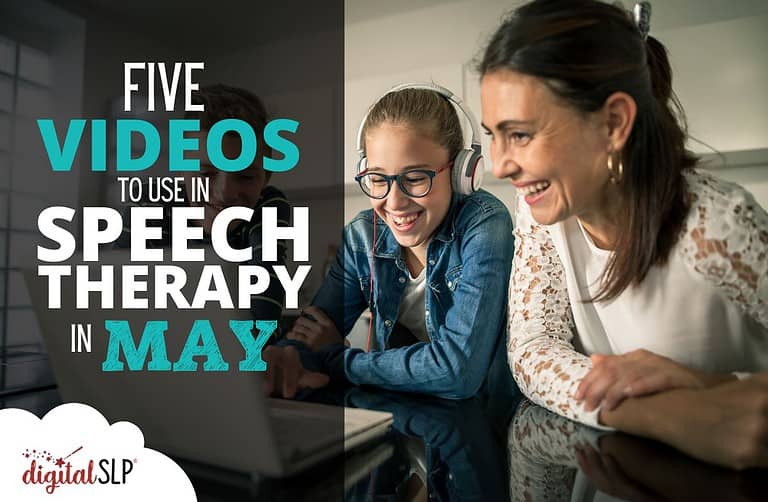Client engagement during any speech therapy session is important, but engagement during teletherapy sessions is essential. In this post, I’ll share some of the most effective strategies I’ve found to support engagement during teletherapy sessions.
Know Your Tools
Investing time in learning your platform can pay incredible dividends when it comes to engagement during teletherapy sessions. One of the most challenging aspects of teletherapy is that if a student’s attention wanders, it can be much more difficult to get it back than when you are with the student in person. On those extra tough days, the student might literally walk away from the computer! Our clients can sense when our attention has shifted to figuring out the technology – and then their attention often shifts as well. Developing a high level of comfort with your platform allows you to focus on the human being sitting on the other side of the screen.
As you learn your platform, try out the various features, even if you think you might not use some of them very much. Having a deep understanding of all the different possibilities allows for maximum flexibility. It can also increase your confidence, because you’ll know that if the session doesn’t go as planned, you can switch things up with ease. One word of caution: As much as possible, practice the various features outside of actual teletherapy sessions before using them with students and clients!
The Power of Silliness
As SLPs, we are doing meaningful work, and often we are stressed out. This combination can result in us taking all of our sessions very seriously, but sometimes, the best learning happens when we lighten up! Also, with teletherapy, everything we do needs to be a bit more enthusiastic and upbeat, because our entire presence has essentially been reduced to a square on a screen. For those who identify as introverts, this can be draining, but there are ways to honor your own personality and support engagement during teletherapy sessions at the same time – even if it just means wearing some funny glasses or taking a dance party break mid-session.
It’s Teletherapy: Embrace It
Particularly for SLPs who first encountered teletherapy unexpectedly during the pandemic, it’s easy to focus on what is lost by not being in person with clients. This is a natural human reaction, but if we get stuck in this mindset, we risk missing the fact that teletherapy also has many unique benefits. One of the best ways to maximize engagement during teletherapy sessions is to embrace the elements that are unique to this method of providing speech therapy. These include:
- In some cases, teletherapy means that the student is in their home environment, which can be incredibly beneficial! Students may feel more comfortable and relaxed, and they have access to their favorite toys and activities – which can then be incorporated in order to support engagement during teletherapy sessions. Having sessions in the student’s home environment also supports carryover.
- During teletherapy sessions, it can be much easier to do a quick check-in with parents and find out how things are going at home between sessions, and offer coaching as appropriate.
- While appropriate boundaries around screen time are important, we can also acknowledge that most children love technology and are motivated by technology. Why not use that inherent motivation to maximize engagement during teletherapy sessions?
- One of the best parts of working as a teletherapist is that the Internet allows us to have the world at our fingertips during our sessions. If we need an image to help a student visualize a vocabulary word, if we need a short film to practice story retell, if a student has a question and we don’t know the answer – we can use technology to access needed resources in real time. In doing so, we can also model curiosity, research skills, and critical thinking for our students.
Go Low-Tech Sometimes
As The Digital SLP, I love technology. I also recognize that each student is different and each session is different, and sometimes we can support engagement during teletherapy sessions by incorporating low/no-tech elements. Here are some favorites:
- Puppets
- Costumes/hats/scarves/themed clothing
- Posters and backdrops taped to the wall
- Stuffed animals
- Inflatables
- House plants (Time for therapy in the “jungle!”)
It’s also possible to pair digital tools with low/no tech tools. For example, if you’re using a picture scene of the desert on your screen, you could wear sunglasses, or put a small cactus on your desk for increased context and engagement.
In addition, students often love to give directions and tell therapists what to do, so it’s possible to elicit an amazing amount of language by playing a game or doing an art project, even if the student doesn’t have the materials on their side. They can “direct” you and describe what you’re doing.
You are Your Own Best Therapy Tool
In the sea of available resources, it’s easy to forget that when it comes to maintaining engagement during teletherapy sessions, the therapist is the most important therapy tool. Focus on finding joy within your sessions, showing up as your authentic self, and building genuine connections with your clients, and you will be amazed at the engagement you will encounter.
Want to stay in the loop for new speech therapy ideas and inspirations? I have put together a free Digital SLP podcast to share insight and tips on implementing your speech therapy sessions. If you are looking for fun and interactive speech therapy materials that students and SLPs both will love, check out what the Digital SLP® membership site has to offer or sign up for our free trial now. Alternatively, check out our TpT store.













Recent Comments